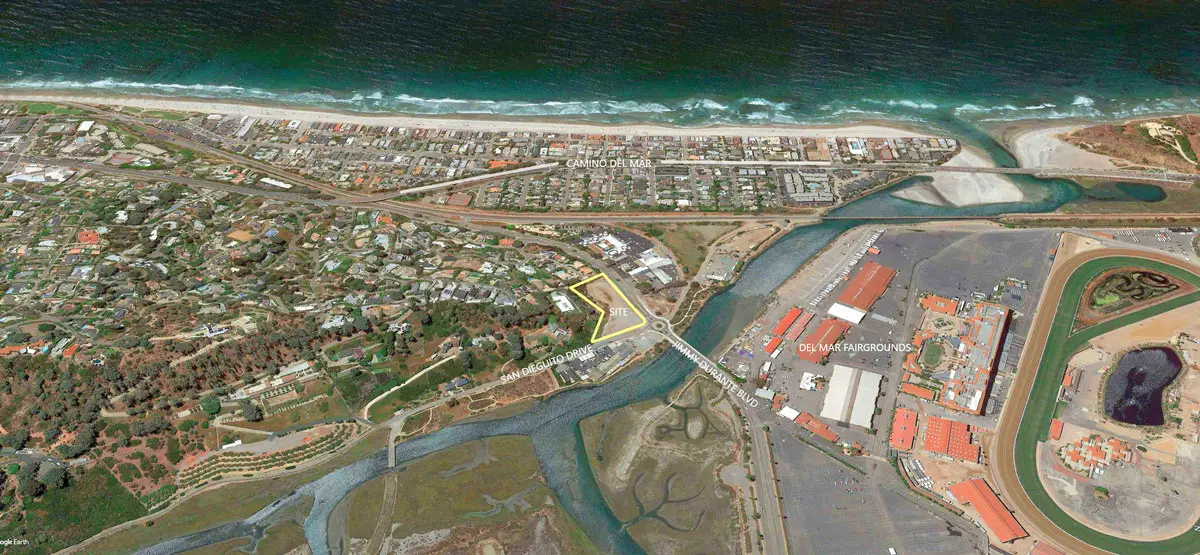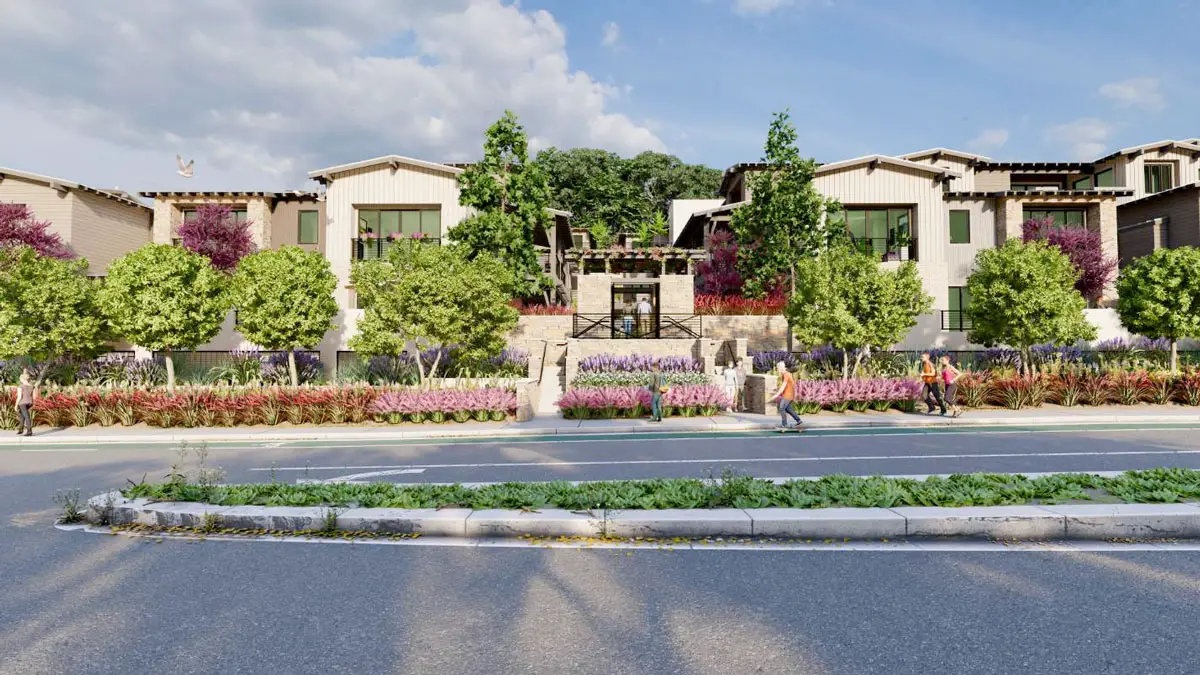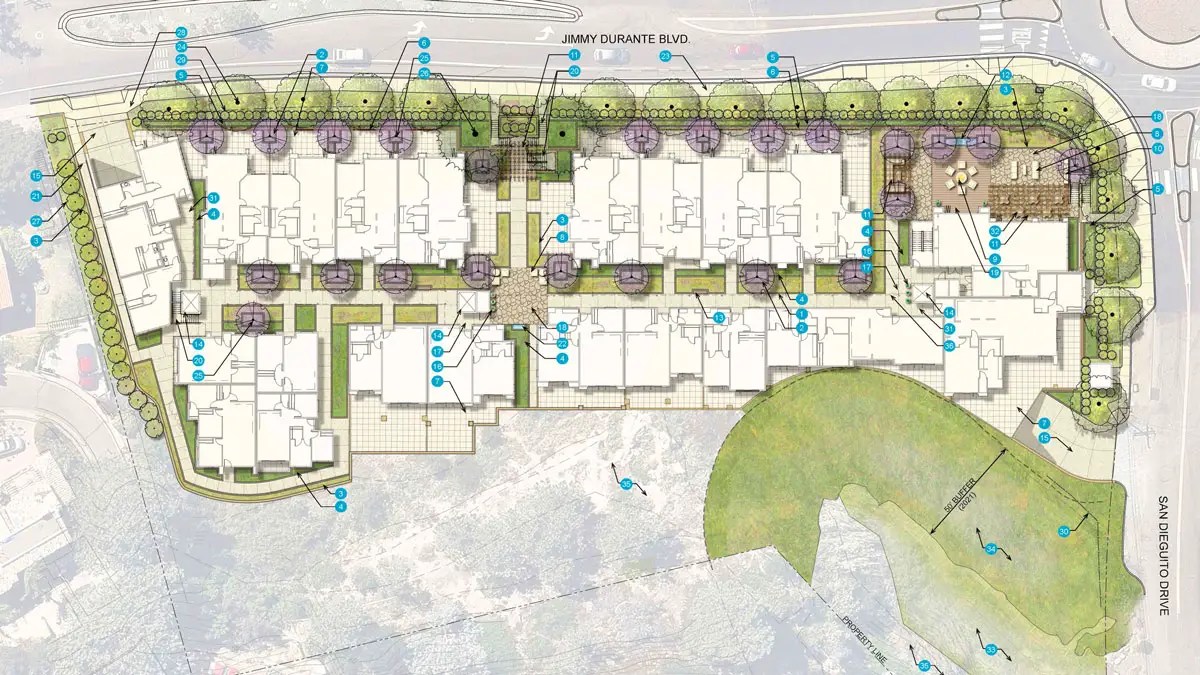DEL MAR — The California Coastal Commission has determined that residents’ appeals of a permit for the Watermark housing development did not raise any significant issues, allowing the project to proceed as the city had previously approved it.
The 50-unit, four-story project planned for the corner of Jimmy Durante Boulevard and San Dieguito Drive has been stalled since May 2022, when the Del Mar Hillside Community Association and resident Jill Schultz each filed an appeal to the state commission, claiming the city issued a permit inconsistent with its Local Coastal Plan (LCP).
Watermark developers submitted the project as a by-right application under Senate Bill 330, requiring the city to forgo discretionary approval. The project also obtained a density bonus for its inclusion of 10 affordable units, allowing an increase in lot coverage from 40% to 51% and a decrease in the wetlands buffer from 100 to 50 feet.

The state’s Density Bonus Law also said that the city could not set standards that would physically stop the building of the project and its affordable units. As a result, the city had to make more concessions, such as letting the slope encroach 10% more and allowing the number of stories to go from two to four, the maximum floor area ratio to go from 0.3 to 1.29, and the height to go from 14 to about 48 feet.
According to the appellants, the project as it is violates the LCP and California Coastal Act in five main ways: it’s too big, blocks public access, threatens wildlife and environmentally sensitive areas like wetlands, and does not follow the rules for steep slope encroachment and flooding.
A year and a half later, on Nov. 17, the commission unanimously agreed that while the project is inconsistent with the LCP in some ways, it does not constitute a substantial issue for the environment.
“In this case, the project has been sited and designed to avoid onsite resources while still providing the required number of residential units. Commission staff have worked with the applicant over the last several years, and while there remain some LCP inconsistencies, such as height, they do not result in coastal resource impacts and do not raise a substantial issue,” said Coastal Planner Stephanie Leach.
Watermark DM, LP, a partnership between San Dieguito Land Partners and Kitchell Corp., has defended the project since its appeal. Project attorney Marco Gonzalez said they have put years of work into making sure it will not only provide affordable housing but also mitigate environmental impacts.

The Watermark project will include the planting of southern coastal bluff scrub plants, the removal of invasive plants to improve the wetland buffer, and a 5-year monitoring plan, all in accordance with the permit that the city has approved.
“What’s happening here is we’re kind of being punished because we did the right thing,” Gonzalez told the commission. “This project has been in the works for 10 years.”
Del Mar City Manager Ashley Jones declined to comment on the Coastal Commission’s decision.
Project concerns
Julie Hamilton, attorney for Schultz, disagreed with the commission’s finding of no substantial issues. She told the commission that there are no mitigation conditions for the development that the developer is required to follow and requested a de novo hearing regarding the project.
“There is nothing binding the applicant to these resource protection mitigation measures,” Hamilton said. “Therefore, there is a substantial issue as to whether you have adequately protected the coastal resources.”
Gonzalez told the commission this “simply isn’t true” and said the mitigation measures were submitted as part of the application to the city and that they worked with the commission extensively to ensure everything else met the requirements of the LCP as much as possible.

The Watermark design includes three residential stories atop a podium parking garage holding 105 parking spots, with unit sizes ranging from studios to three bedrooms. In response to concerns in the appeal about the size and footprint of the project, including its encroachment onto the slope, the commission said these conditions were necessary to accommodate the approved number of units and parking.
Otherwise, the project would have required a subterranean garage that would greatly disturb the natural landscape or the addition of a residential story, potentially impacting public views, Leach said.
The appeal also claimed that the project would negatively impact public access to coastal areas, as the site is used as an alternative parking lot during the San Diego County Fair. The commission said since the lot is unused the majority of the year, the loss of parking would not result in substantial impacts on public access.
Commission staff also disagreed with the assertion that Watermark will impact rare birds in the area. Watermark’s biology report determined it was not a primary nesting area, but the project will still limit impacts during peak migratory breeding season.
Regarding concerns about the floodplain, the commission noted that the garage on the base level is prepared to handle flooding and would prevent impacts on residents.

The commission added that the California Department of Fish and Wildlife also reviewed the project and agreed the 50-foot wetland buffer would be acceptable for the project.
Lastly, in terms of impacts on public views — one of the chief concerns from the public regarding Watermark — the commission said that the top of the sandstone bluff will still be visible, and views of the ocean and San Dieguito Lagoon will not be affected.
“The project also includes features to improve the aesthetics of the area, including undergrounding utility lines, sidewalk and pedestrian improvements, and landscaping. The project will utilize earth-toned materials and colors to blend with the surrounding natural features. Because of these factors, no substantial impact on public views will take place as a result of this project,” the commission said.
Affordable housing need
The affordable units included in the Watermark are key to the city of Del Mar meeting state housing requirements. The city’s Housing Element requires 175 affordable housing units to be built by 2029, including 22 in the north commercial zone where the Watermark project will be located.
Of the 10 affordable units, six are low-income (designated for those making up to 80% of the area median income, or AMI, or lower), two are very low-income (50% AMI or lower), and two are extremely low-income (30% AMI or lower).
Commission staff noted that there are sometimes conflicts between state housing laws and coastal development requirements and that they need to be harmonized whenever possible. Commission Chair Donne Brownsey applauded Watermark developers for including affordable housing for extremely low-income levels.
“We often hear from developers that these [projects] can’t pencil out, and here we’re hearing from a developer where it did pencil out. I just want to commend the developer and commend the project,” Brownsey said.




